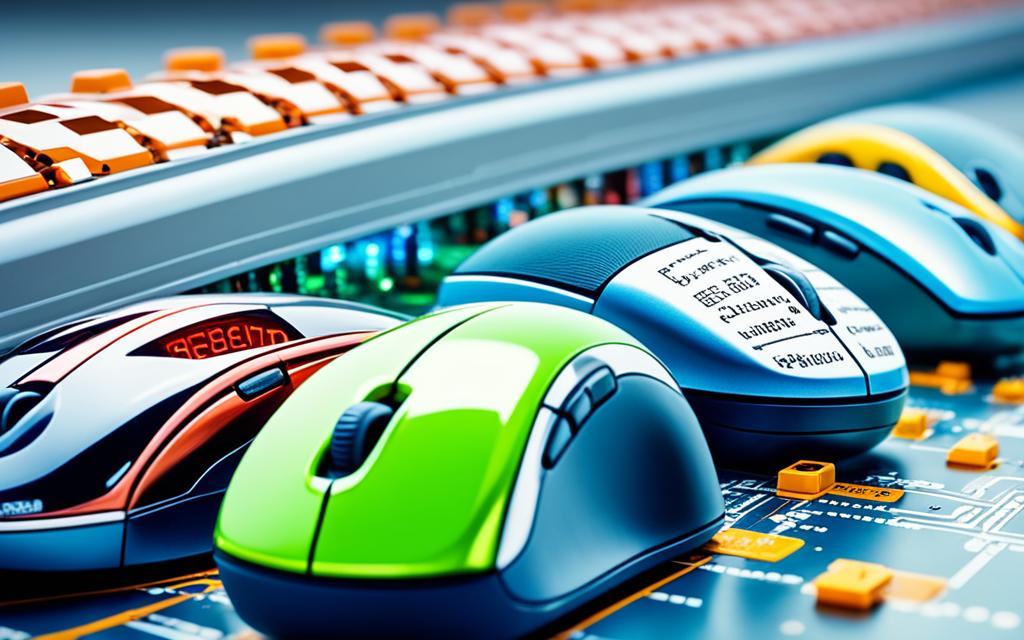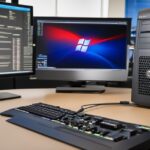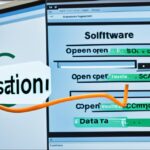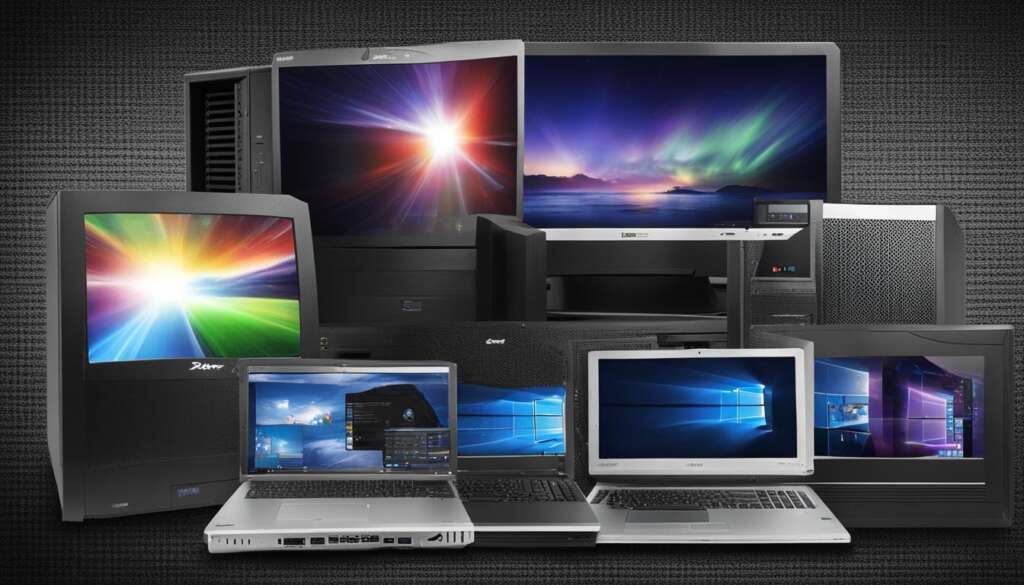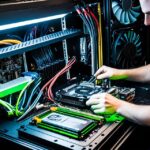Table of Contents
To transfer drivers from one PC to another, follow these instructions. You can use these methods for both Windows and Mac computers. First, copy the driver folder to a flash drive or cloud server. Then, install them on the new PC or Mac using Device Manager (Windows) or Finder (Mac).
Key Takeaways:
- Moving a drive from an AMD to an Intel/Nvidia machine can work smoothly, showing compatibility between different systems1.
- Transferring a Windows drive to a new PC allows for quick access to data after an old PC fails. It acts as a temporary fix1.
- If you’re moving to a new machine for good, it’s wise to start fresh with a clean install1.
- Windows can often install needed drivers automatically, especially with an internet connection. This makes the process easier1.
- In some cases, specific drivers like chipset, audio, and graphics might need manual downloading if not auto-installed by Windows1.
- It’s a good plan to remove old drivers during driver migration. It helps keep the system clean1.
- Switching the drive to a new computer may need Windows re-activation due to hardware changes. This step resolves potential license issues1.
- Windows keeps a copy of each installed driver in C:\Windows\System32\DriverStore\FileRepository. Each driver is in a separate folder, listed alphabetically2.
Method 1: Transferring Drivers on Windows
To transfer drivers on Windows, start by opening File Explorer. Press Win+e on your keyboard. This opens up your files and folders.
In File Explorer, head to C:\Windows\System32\DriverStore\FileRepository. This spot is where Windows keeps each installed driver2. You’ll see folders for each driver, sorted alphabetically2.
Find the driver folder you need to move. Right-click it and choose “Copy.” Next, paste it onto a flash drive. Or, if without a flash drive, use a cloud server like Google Drive. Then download it onto another PC2.
With the driver folder on a flash drive, plug it into the other PC. Then open File Explorer there and go to the desktop. Move the driver folder from the flash to the desktop.
Now, open Device Manager on this second computer. Right-click the Start button and click “Device Manager.” The Device Manager window pops open. Look for the device group you’re updating.
Right-click the device and pick “Properties.” Click the “Driver” tab then “Browse” to find the driver folder on the desktop. Then, follow the directions Windows gives to install the driver2.
These steps make transferring drivers between Windows PCs straightforward. Using File Explorer and Device Manager helps. Ensure you copy the whole driver folder to not miss any files.
Method 2: Transferring Drivers on Mac
To move drivers to your Mac, use the Finder to shift needed driver folders between machines. Just follow these steps:
- Open Finder.
- While pressing the Option key, hit the “Go” menu. This shows the Library option.
- Choose “Library.”
- Double-tap the folder for the drivers you wish to move. For printers, select the “Printers” folder.
- Copy the folder onto a USB drive.
- Plug the USB into the other Mac you’re moving the drivers to.
- Open Finder on this Mac.
- Find the flash drive in the sidebar.
- Look for the copied driver folder on the drive.
- Drag this folder to the right spot on the second Mac’s drive, often “Macintosh HD”.
This method makes sure your second Mac has the drivers, working smoothly.
Moving drivers on Mac is easy, making sure your devices work right. Using Finder’s easy-to-use steps and a flash drive, you can move driver folders between Macs without trouble.
“Using Finder to transfer drivers on a Mac is easy and works well. It lets you move vital driver folders, ensuring devices work together without a hitch.”3
Consider Using Driver Extraction Software
If you’re not sure how to copy drivers yourself, think about using special software. This software can find and pull out drivers from your old computer. It makes it easy to set them up on a new one.
There are big plusses to using driver extraction software. It saves you time and hassle, especially if the hardware is old or hard to support4. shows finding drivers online can be tough for old, rare, or unsupported hardware. For instance, the “Ralink RT61 Turbo” adapter bought in 2009 worked on Windows Vista/7 but not on newer systems without updates.
Driver extraction tools simplify getting drivers from your old computer. Commands like “pnputil.exe /e,” “dism.exe /Online /Get-Drivers,” and “driverquery” can list drivers. This ensures you get all the files you need for your new machine.
The “DriverStore” folder is key for Windows users. You find it at C:\Windows\System32\DriverStore\FileRepository, as4 suggests. It holds all the driver files you need. Copying drivers from here to a new folder makes installing them on another Windows PC easy.
Double Driver is another useful tool. It’s highlighted by4 for its ability to backup drivers. It puts them into a folder for easy access later. Plus, it has a simple GUI for choosing drivers to backup or restore.
Extra stats, like how often people backup drivers, can tell us more about these software’s benefits. It also shows how many drivers typically get backed up.
To wrap up, using driver extraction software is a smart move when switching PCs or Macs. It simplifies the process and makes sure you have what you need for a smooth setup. As4 notes, these tools make the job easier and save you from dealing with hard-to-find or outdated hardware.
Recommended Software Tools for Driver Removal:
| Software | Description |
|---|---|
| WinRAR | A file compression tool that can also extract drivers |
| 7-Zip | An open-source file archiver that supports driver extraction |
| Universal Extractor | A software tool specifically designed for extracting files from installation packages, including drivers |
| UniExtract2 | An updated version of Universal Extractor, offering enhanced driver extraction capabilities |
| lessmsi | A utility for extracting drivers from MSI installers |
Be careful when extracting drivers. As5 advises, some drivers need special steps or multiple tools for extraction. For instance, Chipset and IRST drivers might need command line steps and a restore point created first. Ideally, extract drivers to a temporary folder, like “C:\Users\USER\AppData\Local\Temp”. And remember, pulling out drivers the wrong way could mess up your system, as warned by5.
Ensuring Compatibility and Updating Drivers
When moving drivers from old to new PCs or Macs, checking compatibility is key. Make sure the hardware specs of both devices match. This ensures the drivers will work well together.
After moving drivers, updating them to the latest version is wise. This keeps them compatible and boosts performance with the new system. Out-of-date drivers can cause slow performance, system issues, and security risks6.
There are a few ways to update drivers for better compatibility. One handy tool is Windows Update. It not only gives you system patches but also driver updates. This keeps your system current and works well with different hardware7. Another option is using Device Manager. This lets you update specific drivers by yourself6.
To get the latest enhancements for your device, download drivers from the manufacturers’ websites. This way, you’re sure to have the newest drivers made just for your device6.
For an easier approach, there are tools that update drivers with just one click. They help avoid the trouble of finding and updating drivers manually. These tools are a real time-saver6.
However, be aware that updating drivers might cause issues with existing software. If this happens, going back to a previous driver version can fix the problem. System restore points are also helpful in these situations6.
Companies with many PCs will find endpoint management tools like NinjaOne very helpful. They make updating drivers and managing IT tasks simpler. With these tools, you can ensure all your devices are up to date and working well together6.
| Key Information | Reference |
|---|---|
| Drivers facilitate communication between computer hardware and software applications | 6 |
| Updating drivers ensures compatibility, functionality, stability, and speed of hardware devices | 8 |
| Outdated drivers can lead to performance lags, system instabilities, crashes, and data loss | 6 |
| Updating drivers can enhance cybersecurity by preventing security vulnerabilities | 6 |
| Windows Update is a convenient tool for downloading driver updates | 6 |
| Directly downloading drivers from manufacturers’ websites ensures tailored enhancements | 6 |
| Using Device Manager provides more control over updating individual device drivers | 6 |
| Automated driver update tools offer one-click solutions for identifying and installing outdated drivers | 6 |
| New drivers may conflict with existing software, causing compatibility issues | 6 |
| Rolling back to previous compatible driver versions or using system restore points can resolve driver conflicts | 6 |
| Endpoint management tools like NinjaOne simplify driver updates and overall IT management | 6 |
Common Issues and Troubleshooting
During the driver transfer, you might face issues that disrupt the process. Knowing how to solve these can save you time and frustration. Here are some common problems and how to fix them:
1. Error Messages and Timeouts 9
Error messages might pop up, indicating trouble with the driver installation. For instance, error code 0x000005B4 (ERROR_TIMEOUT) means it took too long and stopped. To fix this, restart the installation, check your internet, or contact the manufacturer’s support.
2. Incompatible Drivers 10
Sometimes, the drivers don’t match with your PC or Mac, causing errors. If this happens, check the manufacturer’s website for support. They might have updates or instructions to fix the issue.
3. Group Policy Blocking 9
Error code 0xe0000248 (ERROR_DEVICE_INSTALL_BLOCKED) shows that a group policy stopped the installation. To solve this, look at your system’s Group Policy settings. Ensure there’s nothing stopping the driver installation.
4. Query Remove Operation Delays 9
Error codes 0x000001e0 and 0x000001e1 point to delays in query remove operations, causing delays. Fix this by closing unneeded apps, delaying other tasks, or retrying the installation after restarting your system.
5. Unknown Devices and Hardware Issues 1110,
Unknown devices might show up in Device Manager for reasons like outdated drivers or faulty hardware. Use Windows Update or download the latest drivers from the manufacturer’s website. For more complex issues, try starting in safe mode, checking the Startup folder, using System Information, and looking at Setupapi.log. For hardware problems, remove devices one by one and check if drivers are signed.
If you run into these issues, stay calm and look for solutions online or on the manufacturer’s website. Understanding these problems helps ensure a smooth and efficient driver transfer.
| Statistical Data | Source |
|---|---|
| Driver Support serves over 4 million users. | Link 2 |
This link offers information on Mac features, setup, customization, and more to enhance your Mac knowledge.
Best Practices for Driver Transfers
To make driver transfers easy, it’s key to follow tried and true steps. This saves time and stops problems during the transfer. Here’s what you should do:
1. Organize Your Drivers
Start by sorting your drivers. Make different folders for categories like graphics, audio, and network drivers. This helps find and transfer what you need quickly and accurately12.
2. Back Up Your Drivers
It’s important to regularly back up your drivers. This is vital for system crashes, hardware changes, or reinstallation needs. Keep backups in a safe place, such as an external drive or the cloud. This way, you’ll always have access to your drivers12.
3. Choose the Right Tools
Different tools can help with driver transfers. Here are some choices:
- PC data transfer software makes moving drivers and files to a new computer easy. EaseUS Todo PCTrans is one tool that does this12.
- For file moving, USB flash drives are a common choice. They work well with fast USB ports like USB 3.0 or USB413.
- Cloud storage, like Microsoft OneDrive, Dropbox, or Google Drive, is great for transferring smaller files from one computer to another12.
- For older Windows versions, a USB transfer cable can be a quicker way to move files12.
- Backup software, like AOMEI Backupper, supports backups that can be restored on different devices. It has a special feature allowing hard drive transfers to new computers without needing to reinstall Windows. AOMEI Backupper also offers business editions for wider deployment1214.
4. Ensure Compatibility and Update Drivers
When moving drivers, ensure they’ll work with the new hardware. Using the latest drivers from their manufacturer helps with better performance and fixing bugs. After transferring, check for updates to keep your system running smoothly14.
5. Troubleshoot and Seek Guidance
If you run into problems, plenty of guides can help. These include steps for using backup software effectively. For more help, customer support and online forums are great resources12.
By keeping these practices in mind, you’ll make your driver transfer more efficient. This ensures a hassle-free setup for your new computer or when moving drivers between PCs.
Conclusion
Moving drivers between PCs and Macs can be easy if you follow some steps. You can copy the driver folders or use special software to move drivers. This makes sure they work well on the new system. Keeping drivers updated is important for your system’s performance.
Using EaseUS Todo PCTrans, according to151, simplifies the transferring process. It lets you move up to 5 programs for free between PCs, even without an internet connection. This tool is great for moving all kinds of software without needing to install them again on Windows 11/10 and 7.
162 outlines effective methods for moving installed programs on Windows 10/11. You can use a USB drive, log into your Microsoft account, use OneDrive, or a tool like AOMEI Partition Assistant. Each method helps you transfer programs to a new computer easily.
To make sure you settle into your new PC or Mac smoothly, solve any problems that come up. Follow the best steps for moving drivers and enjoy using a system that works perfectly on your new device.
FAQ
How do I transfer drivers from one PC to another?
To move drivers from one PC to another, simply copy the driver folder to a flash drive or a cloud server. Then, install them on the new PC using Device Manager for Windows or Finder for Mac. Check out this guide for detailed steps for both Windows and Mac computers.
What is the method for transferring drivers onlobord Windows?
First, press Win+e to open File Explorer on Windows. Head to the driver repo at C:\Windows\System32\DriverStore\FileRepository. Find and copy the driver folder you need.
Next, plug the flash drive into the other PC. Move the driver folder to the desktop and open Device Manager. Find the device you wish to install, right-click, and choose Properties.
Hit the Driver tab, look for the driver folder, and follow the instructions to get the driver installed.
Can I transfer drivers on a Mac?
Yes, transferring drivers on a Mac is possible. Open Finder and access the Go menu while holding the Option key. Choose Library, then double-click on the device’s folder, like Printers for printers.
Copy this folder to a flash drive and plug it into another Mac. In Finder, click the flash drive. Drag the folder to Macintosh HD. This installs the driver in the right Library folder.
Should I consider using driver extraction software?
If you’re unsure about manually moving drivers, think about using driver extraction software. This tool finds and extracts drivers from your old PC or Mac, simplifying installation on the new device.
How can I ensure compatibility and update drivers?
Check the hardware specs of both PCs or Macs to make sure the drivers will fit. After moving them, update the drivers to the latest version. This enhances performance and compatibility with your new system.
What should I do if I encounter issues during the driver transfer process?
If problems pop up, like error messages or driver mismatches, look for help on the manufacturer’s site or online forums. Make sure you have admin rights on both PCs or Macs for installing drivers.
Are there any best practices for driver transfers?
For easier driver transfer, organise your drivers by category in separate folders. Back up your drivers regularly to something like an external drive or cloud storage. This way, you’re ready for system issues or hardware updates.
What can I take away from this guide on transferring drivers?
Moving drivers between PCs or Macs can be straightforward with these instructions. Whether you copy folders manually or use software, ensure compatibility and update drivers. Solve any issues that come up and stick to best practices for a hassle-free switch to your new PC or Mac.
Source Links
- https://www.pcmag.com/how-to/move-your-windows-drive-to-a-new-pc – Good Migrations: How to Move Your Windows Drive to a New PC
- https://www.wikihow.com/Copy-Drivers-from-One-Computer-to-Another-on-PC-or-Mac – How to Copy Drivers from One Computer to Another on PC or Mac
- https://www.easeus.com/backup-utility/how-to-transfer-operating-system-from-one-computer-to-another.html – How to Transfer Operating System from One Computer to Another | 2024 New Tip
- https://www.techspot.com/guides/1714-export-old-device-windows-drivers/ – How to Export Old Device Drivers to a New Windows Installation
- https://winraid.level1techs.com/t/tip-how-to-extract-drivers-from-different-types-of-driver-packages/33814 – TIP : How to extract drivers from different types of driver packages ?
- https://www.ninjaone.com/blog/how-to-update-drivers-on-pcs/ – How to Update Drivers on PCs | Full Guide | NinjaOne
- https://www.driversupport.com/knowledge-article/how-do-you-know-which-drivers-need-updating/ – How Do You Know Which Drivers Need Updating?
- https://www.linkedin.com/advice/0/how-do-you-keep-your-hardware-drivers-firmware – How do you keep your hardware drivers and firmware current?
- https://learn.microsoft.com/en-us/windows-hardware/drivers/install/troubleshooting-device-and-driver-installations – Troubleshooting Device and Driver Installations – Windows drivers
- https://support.microsoft.com/en-us/topic/how-to-troubleshoot-unknown-devices-that-are-listed-in-device-manager-in-windows-xp-3acd0b45-2427-29cb-a85b-3778225fa48f – How to troubleshoot unknown devices that are listed in Device Manager in Windows XP
- https://www.driversupport.com/knowledge-article/fix-device-driver-problems-in-windows/ – Fix Device Driver Problems in Windows
- https://www.easeus.com/pc-transfer/transfer-files-from-old-pc-to-new-pc-in-windows-10.html – How Do I Transfer Everything from My Old Computer to My New Computer?
- https://www.makeuseof.com/tag/5-ways-to-transfer-files-from-one-computer-to-another/ – 5 Ways to Transfer Files From One Computer to Another
- https://www.ubackup.com/windows-10/move-hard-drive-to-new-computer-windows-10.html – Move Windows 10/11 Hard Drive to a New Computer (Worry-Free)
- https://www.easeus.com/pc-transfer/copy-installed-software.html – Transferring Installed Programs from One Computer to Another Windows 11/10
- https://www.diskpart.com/articles/transfer-installed-program-to-another-pc-windows-10-0825.html – How to Transfer Installed Programs to Another PC on Windows 10

